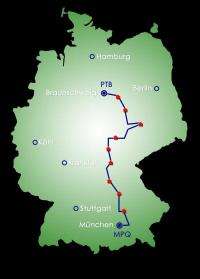Redefining time

Atomic clocks based on the oscillations of a cesium atom keep amazingly steady time and also define the precise length of a second. But cesium clocks are no longer the most accurate. That title has been transferred to an optical clock housed at the U.S. National Institute of Standards and Technology (NIST) in Boulder, Colo. that can keep time to within 1 second in 3.7 billion years. Before this newfound precision can redefine the second, or lead to new applications like ultra-precise navigation, the system used to communicate time around the globe will need an upgrade. Recently scientists from the Max Planck Institute of Quantum Optics, in the south of Germany, and the Federal Institute of Physical and Technical Affairs in the north have taken a first step along that path, successfully sending a highly accurate clock signal across the many hundreds of kilometers of countryside that separate their two institutions.
The researchers will present their finding at Conference on Lasers and Electro Optics (CLEO: 2012), taking place May 6 -11 in San Jose, Calif.
"Over the last decade a new kind of frequency standard has been developed that is based on optical transitions, the so-called optical clock," says Stefan Droste, a researcher at the Max Planck Institute of Quantum Optics. The NIST optical clock, for example, is more than one hundred times more accurate than the cesium clock that serves as the United States' primary time standard.
Extremely precise time keeping—and the ability to communicate the world time standard across long distances—is vital to myriad applications, including in navigation, international commerce, seismology, and fundamental quantum physics. Unfortunately, the satellite-based links currently used to communicate that standard are not up to the task of transmitting such a stable signal, so the second retains its less precise measure. Optical fiber links could work better, but had previously been tested only over short distances, such as those separating buildings on the same campus or within the same urban area.
"The average distance between institutes that operate frequency standards in Europe is on the order of a few thousand kilometers," notes Droste. "Spanning these great distances with an optical link is challenging not only because of the additional degradation of the transferred signal, but also because multiple signal conditioning stations need to be installed and operated continuously along the link path." Droste and his colleagues were able to overcome the challenges by installing nine signal amplifiers along a 920-kilometer-long fiber link. They successfully transferred a frequency signal with more than 10 times the accuracy than would be required for today's most precise optical clocks.
More information: www.cleoconference.org
Provided by Optical Society of America

















